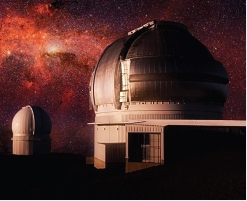Printed Page 861
CHAPTER 12 PROJECTSearching for Exoplanets

To find an exoplanet generally requires powerful telescopes, but some can be observed by amateur astronomers with smaller telescopes and careful observation using the transit method. When using less powerful telescopes, however, very small errors can greatly affect the results of the observation since the change in apparent brightness of the star because of the transit is at most a few percent. Atmospheric scintillation, the main source of error, refers to variations, due to differences in the index of refraction of Earth’s atmosphere, in the apparent brightness (magnitude) of an extrasolar object. When a star is viewed through a lens, the error E in magnitude due to atmospheric scintillation is estimated by E(D,Z,h,T)=0.09D−2/3(2T)−1/2(1cosZ)1.75e(−h/8000)
where D is the diameter, in centimeters, of the lens of the telescope; Z is the zenithal angle, in degrees, of the planet; h is the altitude, in meters above sea level, of the telescope; and T is the exposure time in seconds. The zenithal angle is defined to be the angle from the highest point in the sky (Z=0∘) to an object in the heavens, and it is important because there is less atmosphere to get in the way of viewing a star that is higher in the sky. To obtain observations accurate enough to detect the small fluctuation that would indicate the transit of an exoplanet, the fluctuation in magnitude due to scintillation needs to be smaller than 0.001.
1. Suppose the diameter of the telescope lens is 7.1cm, the zenithal angle is 20∘, and the altitude of the telescope is 3000m. What is the minimum exposure time needed to keep the error E in magnitude below 0.001? Round the answer to the nearest second.
2. Repeat Problem 1 for h=4000m and h=5000m. Comment on the effect of altitude on the error. Explain why your result makes sense in terms of the effects of atmospheric scintillation.
3. Find lim and \lim\limits_{Z\rightarrow 90} E(7.1, Z, 3000,180). Comment on the effect of the zenithal angle on the error.
4. Find \dfrac{\partial E}{\partial D}. Interpret \dfrac{ \partial E}{\partial D}.
5. Find \dfrac{\partial E}{\partial Z}. Interpret \dfrac{ \partial E}{\partial Z}.
6. Find \dfrac{\partial E}{\partial h}. Interpret \dfrac{ \partial E}{\partial h}.
7. Find \dfrac{\partial E}{\partial T}. Interpret \dfrac{ \partial E}{\partial T}.
8. Find the differential dE. Interpret dE.
9. Suppose D=7.1, Z=20, h=3000, and T=180. Use the differential to determine which of the following reduces the error by a greater amount:
(a) using a telescope with a lens of diameter of 7.3\;{\rm cm}, or
(b) using a platform to increase the altitude of the telescope to 3200\;{\rm m}.
10. Suppose you are interested in astronomy and searching for exoplanets. You research the cost of telescopes with different-size lenses and the resulting effects that the different lenses will have on your observations. Do a cost benefit analysis, and then write a position paper supporting your decision to purchase the telescope you chose.